Subscribe to our ▶️ YouTube channel 🔴 for the latest videos, updates, and tips.
Addition of Decimal Fractions
In addition of decimal fractions we will discuss here how to add two or more decimals.
Addition of decimal numbers are similar to addition of whole numbers. We convert them to like decimals and place the numbers vertically one below the other in such a way that the decimal point lies exactly on the vertical line. Add as usual as we learnt in the case of whole numbers.
The rules of adding decimal numbers are:
(i) Write the digits of the given numbers one below the other such that all the decimal points are in the same vertical line.
(ii) Add as we add whole numbers.
(iii) Put the decimal point of the sum vertically below the other decimal points.
Let us consider some of the following examples on addition of decimal numbers.
1. Add 14.02, 198.3, 394.051.
First convert all the decimals to be added into like decimals i.e. 14.02 into 14.020, 198.3 into 198.300 and 394.051 will remain same.
14.020 + 198.300 + 394.051
Now write the decimals in column in such a way that the decimal points of all the decimals are in the same column and then add the decimal ignoring the decimal point.
Atlast, put the decimal point in the sum directly under the decimal points of all the decimals.
Answers: 606.371
2. Add $ 205.40, $ 80.75 and $ 1493.50.
Here, all the decimal numbers are in like decimals.
$ 205.40 + $ 80.75 + $ 1493.50
Now write the decimals in column in such a way that the decimal points of all the decimals are in the same column and then add the decimal ignoring the decimal point.
Answers: 1779.65
3. Add 143.21; 89.025;1001.002; 975.35
Here, all the decimal numbers are in like decimals.
143.210 + 89.025 + 1001.002 + 975.350
Now write the decimals in column and add as we add whole numbers.
Answers: 2208.587
4. Add: 7.035; 8005.007; 91.71; 15.9142
First convert all the decimals to be added into like decimals i.e. 7.035
into 7.0350, 8005.007 into 8005.0070, 91.71 into 91.7100 and 15.9142 will remain as it is.
7.0350 + 8005.0070 + 91.7100 + 15.9142
Now write the decimals in column and add as we add whole numbers.
Answers: 8119.6662
5. Add: 81.71; 198.001; 2071.1945; 9.09
Convert all the decimals to be added into like decimals i.e. 81.71 into 81.7100, 198.001 into 198.0010, 2071.1945 will remain as it is and 9.09 into 9.0900.
81.7100 + 198.0010 + 2071.1945 + 9.0900
Answers: 2359.9955
6. Add: 43.91; 108.431; 832.01
Convert all the decimals to be added into like decimals i.e. 81.71
into 81.7100, 198.001 into 198.0010, 2071.1945 will remain as it is and 9.09 into 9.0900.
43.910 + 108.431 + 832.010
Answers: 984.351
7. Add: 91.4; 31.83; 101
Convert all the decimals to be added into like decimals.
91.40 + 31.83 + 101.00
Answers: 224.23
8. Add: 79.03; 13; 55.05
Convert all the decimals to be added into like decimals.
79.03 + 13.00 + 55.05
Answers: 147.08
9. Add 19.405; 20.21 and 8.1
Solution:
Converting the given decimals into like decimals, we get 19.405; 20.210 and 8.100
Hence, 19.405 + 20.210 + 8.100 = 47.715
10. Add $15.25; $60.98 and $10.5
Solution:
Converting the given decimals into like decimals, we get $15.25; $60.98 and $10.50
Hence, 15.25 + 60.98 + 10.50 = $86.73
11. Complete the given magic square. The sum of all rows and column is 9.0.
Solution:
Sum of the first row = 4.8 + 0.6 + 3.6 = 9
Sum of the second row = 1.8 + 3.0 + 4.2 = 9
Sum of the third row = 2.4 + 5.4 + 1.2 = 9
Again,
Sum of the first column = 4.8 + 1.8 + 2.4 = 9
Sum of the second column = 0.6 + 3.0 + 5.4 = 9
Sum of the second column = 3.6 + 4.2 + 1.2 = 9
Working Rules for Addition of Decimals:
For addition of decimals, we have to follow these steps:
Step I: Change the given decimal into like decimals.
Step II: Write the numbers in columns, so that decimal points should come in one column.
Step III: Now, add the decimals just as we add the whole numbers.
Step IV: Put the decimal in the sum directly under the decimal points of all the decimals.
Solved Examples on Addition of Decimals:
1. Add 7.086, 12 and 17.24.
Solution:
|
Converting into like decimals. 7.086 → 7.086 12 → 12.000 17.24 → 17.240 |
7.086 + 12.000 + 17.240 36.326 |
Therefore, 7.086 + 12 + 17.24 = 36.326
2. Add 3.85 and 2.5
Solution:
|
Converting into like decimals. 3.85 → 3.85 2.5 → 2.50 |
1 + 3 . 0 0 + 2 . 5 0 6 . 3 5 |
Therefore, 3.85 + 2.5 = 6.35
● Decimal.
- Decimal Place Value Chart.
- Expanded form of Decimal Fractions.
- Like Decimal Fractions.
- Unlike Decimal Fraction.
- Equivalent Decimal Fractions.
- Changing Unlike to Like Decimal Fractions.
- Ordering Decimals
- Comparison of Decimal Fractions.
- Conversion of a Decimal Fraction into a Fractional Number.
- Conversion of Fractions to Decimals Numbers.
- Addition of Decimal Fractions.
- Problems on Addition of Decimal Fractions
- Subtraction of Decimal Fractions.
- Problems on Subtraction of Decimal Fractions
- Multiplication of a Decimal Numbers.
- Multiplication of a Decimal by a Decimal.
- Properties of Multiplication of Decimal Numbers.
- Problems on Multiplication of Decimal Fractions
- Division of a Decimal by a Whole Number.
- Division of Decimal Fractions
- Division of Decimal Fractions by Multiples.
- Division of a Decimal by a Decimal.
- Division of a whole number by a Decimal.
- Properties of Division of Decimal Numbers
- Problems on Division of Decimal Fractions
- Conversion of fraction to Decimal Fraction.
- Simplification in Decimals.
- Word Problems on Decimal.
5th Grade Numbers Page
5th Grade Math Problems
From Addition of Decimal Fractions to HOME PAGE
Didn't find what you were looking for? Or want to know more information about Math Only Math. Use this Google Search to find what you need.

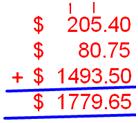

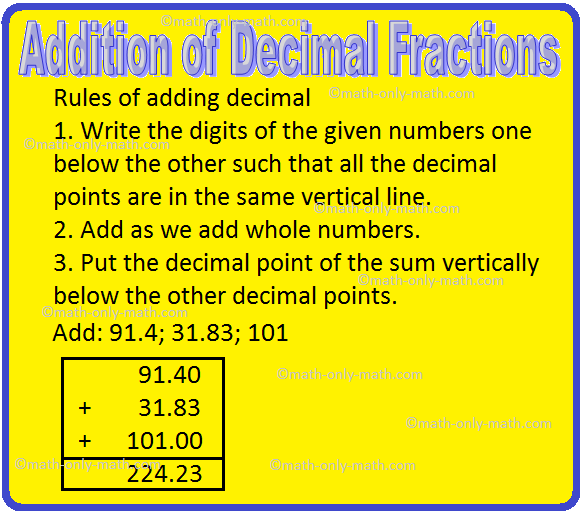





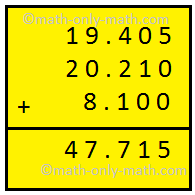
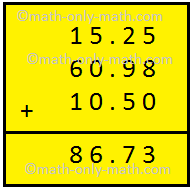
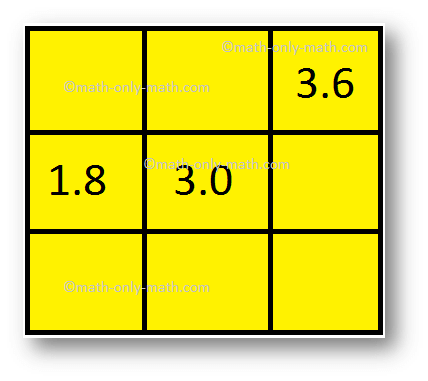
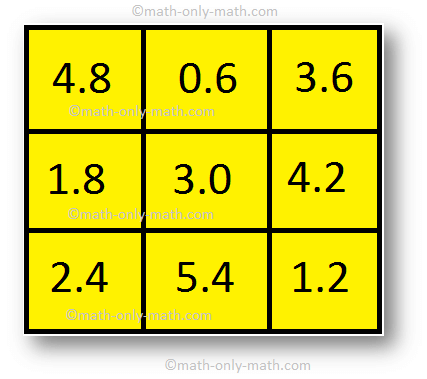


New! Comments
Have your say about what you just read! Leave me a comment in the box below. Ask a Question or Answer a Question.